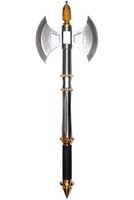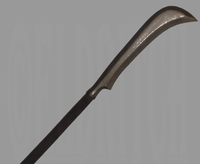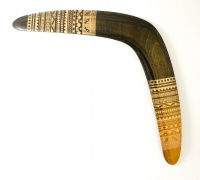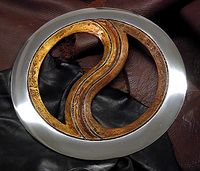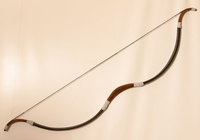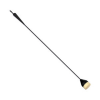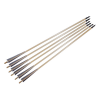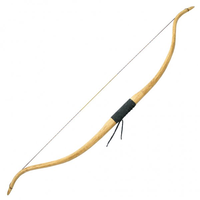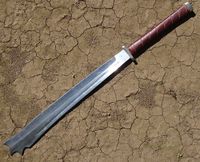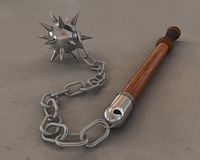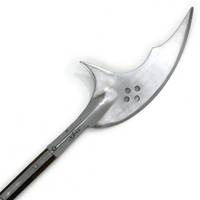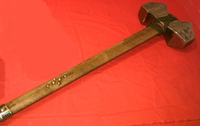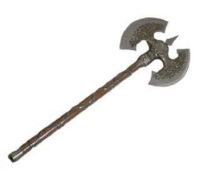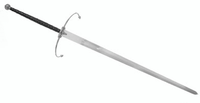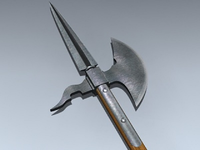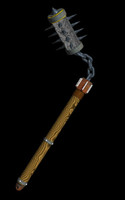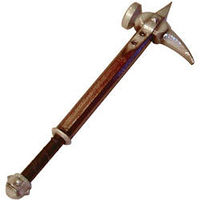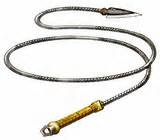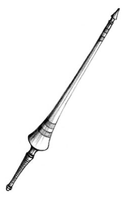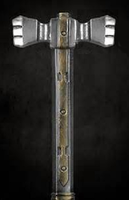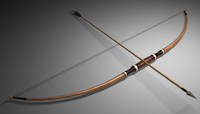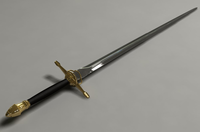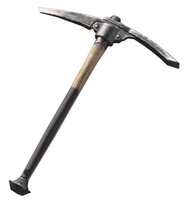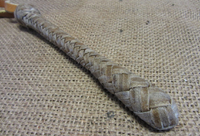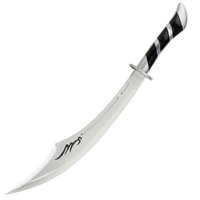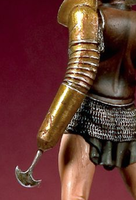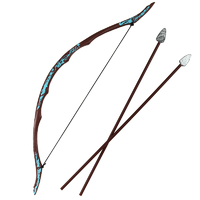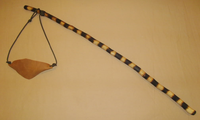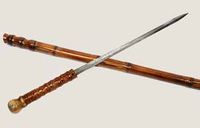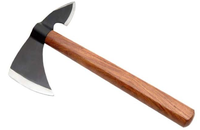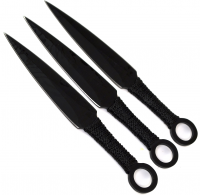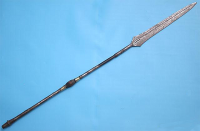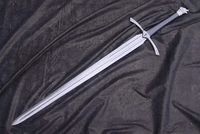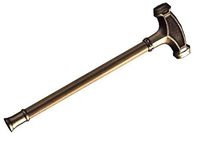Martial Weapons
- Bardiche (Weapon)
Bardiche 2-Hand / Martial [edit] Cost Sm Dmg Med Dmg Large Dmg Crit Range Wt Type 13 gp 1d8 1d10 2d8 19-20 x2 - 12 lbs Slashing (physical, common) Weapon Qualities: Brace, Reach, Stout, Hewing A bardiche has a huge curving blade which attaches to its sturdy haft in two places. They are useful polearms, with the added advantage of being extremely durable due to their solid and redundant construction techniques. They are long enough that they allow attacks and threaten against squares ten feet (2 squares) from the wielder, but do not allow attacks or threaten adjacent squares. A bardiche adds a +2 bonus to the users Maneuver Defense to resist sunder attempts. The Bardiche belongs to the "Axes" and "Polearms" weapon groups. - Battleaxe (Weapon)
Battleaxe 1-Hand / Martial [edit] Cost Sm Dmg Med Dmg Large Dmg Crit Range Wt Type 10 gp 1d6 1d8 2d6 x3 - 5 lbs Hacking (physical, uncommon) Weapon Qualities: Battering, Stout Few weapons are so plainly suited for their work as the battleaxe. Roughly three feet long, they come in a myriad of head types, one and two edged, in almost every conceivable shape. They are all solid, no-nonsense martial weapons. Their top-heavy blades demand some skill to use well. The Battleaxe belongs to the "Axes" weapon group, and is treated as a slashing weapon for the application of Weapon Properties, Feats, Dweomermetals and all other effects. - Bill (Weapon)
Bill 2-Hand / Martial [edit] Cost Sm Dmg Med Dmg Large Dmg Crit Range Wt Type 8 gp 1d10 3d4 5d4 x3 - 10 lbs Slashing (physical, common) Weapon Qualities: Pilfering, Reach A bill is a hefty forward hooked blade sharpened on the inner curve only. They are simple and sturdy devices, granting the user reach, and they hit really hard, even for polearms. Bills are surprisingly common as tools and farm implements, where they are called brush hooks or pruning hooks. In the hands of a user with martial weapons skill, the lowly farm implement becomes an extremely lethal, if unsophisticated, weapon. They are long enough that they allow attacks and threaten against squares ten feet (2 squares) from the wielder, but do not allow attacks or threaten adjacent squares. The Bill belongs to the "Polearms" weapon group. - Boomerang (Weapon)
Boomerang 1-Hand Thrown / Martial [edit] Cost Sm Dmg Med Dmg Large Dmg Crit Range Wt Type 1 gp 1d4 1d6 1d10 x2 30 ft 3 lbs Bludgeoning (physical, common) Weapon Qualities: Melee Capable A boomerang is a heavy blunt object, usually two to four feet long, and almost always crafted with a distinct bend in the middle. Boomerangs are often made of bone or wood, and despite their simple appearance have a high degree of craft and skill in achieving a stable and controllable thrown flight path. Despite their considerable range and good damage, boomerangs are also perfectly fine melee weapons and may be used in one hand in melee without penalty. Boomerangs are not light weapons, however, so fighting with two boomerangs is fraught with difficulty. Many boomerangs are finely decorated with scrimshaw and carvings. The Boomerang belongs to the "Thrown" weapon groups. - Chakram (Weapon)
Chakram 1-Hand Thrown / Martial [edit] Cost Sm Dmg Med Dmg Large Dmg Crit Range Wt Type 10 gp 1d6 1d8 2d6 19-20x2 30 ft 3 lbs Slashing (physical, common) Weapon Qualities: Poor Melee A chakram is an elegant throwing weapon consisting of a balanced ring made of metal or other hard substance that is thrown with one hand. As a thrown weapon, Strength is used for damage adjustments, and unless enchanted, the chakram must be recovered for reuse from the square upon which it was targeted. An enchanted chakram is tremendous fun to use or watch being used, gracefully orbiting around the battlefield making the best noises ever. A chakram is not very good as a melee weapon, incurring a -2 penalty to-hit, but it does allow you to threaten, flank, and take attacks of opportunity. The chakram belongs to the "Blades, Heavy" and "Thrown" weapon groups. - Composite Longbow (Weapon)
Composite Longbow 2-Hand Projectile / Martial [edit] Cost Sm Dmg Med Dmg Large Dmg Crit Range Wt Type 100 gp see ammo see ammo see ammo see ammo see ammo 3 lbs Piercing (physical, common) or by ammunition Weapon Qualities: Mighty, Non-Melee The composite longbow is a large complex bow whose limbs are built up of various materials, usually in a recurve shape. You need at least two hands to use a bow, regardless of its size. You can use a composite longbow while mounted. All composite bows are made with a particular strength rating (that is, each requires a minimum Strength modifier to use with proficiency). If your Strength bonus is less than the strength rating of the composite bow, you can't effectively use it, so you take a -2 penalty to-hit on attacks with it, per plus of Strength modifier greater than your own. The default composite longbow requires a Strength modifier of +0 or higher to use with proficiency. A composite longbow can be made with a high strength rating to take advantage of an above-average Strength score; this feature allows you to add your Strength bonus to damage, up to the maximum bonus indicated for the bow. Each point of Strength bonus granted by the bow adds 100 gp to its cost. If you have a penalty for low Strength, you apply it to damage rolls when you use a composite longbow, in addition to the to-hit penalty for insufficient Strength. For purposes of Weapon Proficiency and similar feats, a composite longbow is treated as if it were a longbow. The composite longbow belongs to the "Bows" weapon group.
Show / Hide Ammunition TypesAmmo Type Cost Sm Dmg Med Dmg Large Dmg Crit Range Wt Type Common Arrow 5 cp each 1d6 1d8 2d6 x3 100 ft 0.1 lbs each Piercing (physical, common) Weapon Qualities: Expendable Common arrows are standard bow ammunition. They have sturdy diamond points on them, they're shafted with easy to get ash, maple, or willow, and they have reliable goose-feather fletchings. They do a bit less damage in shortbows than they do in longbows, and a bit less damage in longbows than they do in greatbows. A common arrow is denoted by that classic, deadly but easy to make, diamond-shaped point. It's good against armor, it's good against beasts, and it can be made quickly. You'll see these everywhere, and rightly so, because they're great. Ammo Type Cost Sm Dmg Med Dmg Large Dmg Crit Range Wt Type Barbed Arrow 2 gp each 1d4 1d6 1d10 x3 50 ft 0.5 lbs each Slashing (physical, common) Weapon Qualities: Expendable, Weapon Qualities: Special The barbed arrow is a specialty product, since making that extravagant head takes a lot of time and skill. Barbed arrows are based off broadhead arrows, with all their characteristics, but they do the same damage as flight arrows. So why bother with them? Because to remove a barbed arrowhead is a deadly and dangerous process. To remove a barbed arrow after you've been struck by one and taken damage past any DR requires greater than animal intelligence and a heal check against an Easy DC. Either the victim or an adjacent creature can attempt to remove barb heads. Failing the heal check means removing the barbed arrow inflicts 1d6 of additional damage which cannot be reduced by DR. Ouch. Ammo Type Cost Sm Dmg Med Dmg Large Dmg Crit Range Wt Type Blunt Arrow 5 sp each 1d6 1d8 2d6 x3 50 ft 0.5 lbs each Bludgeoning (physical, common) Weapon Qualities: Expendable Take a broadhead arrow and remove that big, deadly steel point. Replace it with a shaped boiled-leather cup into which a tightly rolled mass of cotton cloth is firmly wedged, presenting the firm, flat side of the roll toward the front of the arrow. What you get is the blunt arrow, which does bludgeoning damage rather than piercing damage. Why would you do this? Well, hunting of some delicate game species is easier with blunt arrows. Blunt arrows have the same construction as broadhead arrows, but to keep that heavy, flat tip pointed right, they suffer a reduced range increment. Ammo Type Cost Sm Dmg Med Dmg Large Dmg Crit Range Wt Type Broadhead Arrow 3 sp each 1d8 1d10 2d8 x3 50 ft 0.25 lbs each Piercing (physical, common) Weapon Qualities: Expendable The obvious difference to a broadhead arrow is the head, which is a heavy delta-shaped thing with sharp wings and modest barbs. They have more steel in them than common heads, and the blacksmith has to spend some time on them compared to diamond points. The shaft of the broadhead arrow is made of a dense, heavy wood like buckeye, hickory, or dogwood to maintain the proper spine with that heavy head on it. And instead of three fletchings a broadhead arrow has four, to keep that big-winged head pointed the right direction. As a result, broadheads are expensive, short-ranged, and weigh over twice as much as a standard arrow, but they hit really hard. Ammo Type Cost Sm Dmg Med Dmg Large Dmg Crit Range Wt Type Flaming Arrow 3 gp each 1d4 1d6 1d10 x3 50 ft 0.5 lbs each Piercing (physical, common) Weapon Qualities: Expendable Flaming arrows are an age-old terror weapon. Flaming arrows are based off broadheads, as the dense, hardwood shafts are required to allow them to do their fiery work. The massive broadhead is removed and replaced with a small needle-like head with a hole in it. Through the hole is threaded a soft rag of cotton, wool, or linen and the whole thing is soaked in tar and wrapped around the head and top of the shaft. This is allowed to cool into a solid, flammable mass. Lighting a flaming arrow requires a move action and access to a considerable source of flame (larger than a torch, such as a good fire or a brazier). Any amount of magical flame will touch one off, as well. Once lit, a flaming arrow burns for 5 rounds, regardless of wind or rain, although being underwater or doused by a bucket will extinguish it. Flaming arrows do piercing damage as above, as well as 1d4 of fire damage to creatures struck. When fired at flammable structures like cloth wagon covers, thatch roofs, haystacks, etc, they ignite such things automatically the next round unless doused. On light wooden structures they ignite on a 1-2 on a d6 roll. On heavy wooden structures they ignite after three rounds on a roll of 1 on a d10. See the Environmental Effects rules for how to put things out again. Fire Arrows get really scary when you fire a few hundred of them at once.... Ammo Type Cost Sm Dmg Med Dmg Large Dmg Crit Range Wt Type Flight Arrow 5 sp each 1d4 1d6 1d10 x3 150 ft 0.05 lbs each Piercing (physical, common) Weapon Qualities: Expendable Flight arrows are designed for the maximum possible range. As a result, they use common diamond-tip arrowheads in good quality steel but in very small sizes. The shafts are made of kiln-dried lightweight woods, like alder, fir, spruce, or cedar. And the fletching is small, often made of chicken feathers rather than goose. The result is an arrow that is the same size as a regular arrow but weighs about half as much and is ridiculously streamlined. Flight arrows shoot like lightning, and are what are used in target shooting competitions. Ammo Type Cost Sm Dmg Med Dmg Large Dmg Crit Range Wt Type Whistling Arrow 1 gp each 1d4 1d6 1d10 x3 100 ft 0.1 lbs each Piercing (physical, common) Weapon Qualities: Expendable, Audible Take a common arrow, replace that simple but elegant diamond point with a whistling cage made of bent rod, and you create a whistling arrow. These are audible in flight to a distance of 50 feet from the path of their flight, so they're pretty darn loud. They make a distinctive falling shriek as they fly that sounds eerie, especially if you get a few hundred going all at once. Great fun, but expensive. Whistling arrows even do reasonable damage, since they have a functional chisel point atop the whistling cage. - Composite Shortbow (Weapon)
Composite Shortbow 2-Hand Projectile / Martial [edit] Cost Sm Dmg Med Dmg Large Dmg Crit Range Wt Type 75 gp see ammo see ammo see ammo see ammo see ammo 2 lbs Piercing (physical, common) or by ammunition Weapon Qualities: Mighty, Non-Melee The composite shortbow is a small but complex bow whose limbs are built up of various materials, usually in a recurve shape. You need at least two hands to use any bow, regardless of its size. You can use a composite shortbow while mounted. All composite bows are made with a particular strength rating (that is, each requires a minimum Strength modifier to use with proficiency). If your Strength bonus is less than the strength rating of the composite bow, you can't effectively use it, so you take a -2 penalty to-hit on attacks with it, per plus of Strength modifier greater than your own. The default composite bow requires a Strength modifier of +0 or higher to use with proficiency. A composite shortbow can be made with a high strength rating to take advantage of an above-average Strength score; this feature allows you to add your Strength bonus to damage, up to the maximum bonus indicated for the bow. Each point of Strength bonus granted by the bow adds 75 gp to its cost. If you have a penalty for low Strength, apply it to damage rolls when you use a composite shortbow, in addition to the to-hit penalty for insufficient Strength. For purposes of Weapon Proficiency and similar feats, a composite shortbow is treated as if it were a shortbow. The composite shortbow belongs to the "Bows" weapon group.
Show / Hide Ammunition TypesAmmo Type Cost Sm Dmg Med Dmg Large Dmg Crit Range Wt Type Common Arrow 5 cp each 1d4 1d6 1d10 x3 60 ft 0.1 lbs each Piercing (physical, common) Weapon Qualities: Expendable Common arrows are standard bow ammunition. They have sturdy diamond points on them, they're shafted with easy to get ash, maple, or willow, and they have reliable goose-feather fletchings. They do a bit less damage in shortbows than they do in longbows, and a bit less damage in longbows than they do in greatbows. A common arrow is denoted by that classic, deadly but easy to make, diamond-shaped point. It's good against armor, it's good against beasts, and it can be made quickly. You'll see these everywhere, and rightly so, because they're great. Ammo Type Cost Sm Dmg Med Dmg Large Dmg Crit Range Wt Type Barbed Arrow 2 gp each 1d3 1d4 1d8 x3 30 ft 0.5 lbs each Slashing (physical, common) Weapon Qualities: Expendable, Weapon Qualities: Special The barbed arrow is a specialty product, since making that extravagant head takes a lot of time and skill. Barbed arrows are based off broadhead arrows, with all their characteristics, but they do the same damage as flight arrows. So why bother with them? Because to remove a barbed arrowhead is a deadly and dangerous process. To remove a barbed arrow after you've been struck by one and taken damage past any DR requires greater than animal intelligence and a heal check against an Easy DC. Either the victim or an adjacent creature can attempt to remove barb heads. Failing the heal check means removing the barbed arrow inflicts 1d6 of additional damage which cannot be reduced by DR. Ouch. Ammo Type Cost Sm Dmg Med Dmg Large Dmg Crit Range Wt Type Blunt Arrow 5 sp each 1d4 1d6 1d10 x3 30 ft 0.5 lbs each Bludgeoning (physical, common) Weapon Qualities: Expendable Take a broadhead arrow and remove that big, deadly steel point. Replace it with a shaped boiled-leather cup into which a tightly rolled mass of cotton cloth is firmly wedged, presenting the firm, flat side of the roll toward the front of the arrow. What you get is the blunt arrow, which does bludgeoning damage rather than piercing damage. Why would you do this? Well, hunting of some delicate game species is easier with blunt arrows. Blunt arrows have the same construction as broadhead arrows, but to keep that heavy, flat tip pointed right, they suffer a reduced range increment. Ammo Type Cost Sm Dmg Med Dmg Large Dmg Crit Range Wt Type Broadhead Arrow 3 sp each 1d6 1d8 2d6 x3 30 ft 0.25 lbs each Piercing (physical, common) Weapon Qualities: Expendable The obvious difference to a broadhead arrow is the head, which is a heavy delta-shaped thing with sharp wings and modest barbs. They have more steel in them than common heads, and the blacksmith has to spend some time on them compared to diamond points. The shaft of the broadhead arrow is made of a dense, heavy wood like buckeye, hickory, or dogwood to maintain the proper spine with that heavy head on it. And instead of three fletchings a broadhead arrow has four, to keep that big-winged head pointed the right direction. As a result, broadheads are expensive, short-ranged, and weigh over twice as much as a standard arrow, but they hit really hard. Ammo Type Cost Sm Dmg Med Dmg Large Dmg Crit Range Wt Type Flaming Arrow 3 gp each 1d3 1d4 1d8 x3 30 ft 0.5 lbs each Piercing (physical, common) Weapon Qualities: Expendable Flaming arrows are an age-old terror weapon. Flaming arrows are based off broadheads, as the dense, hardwood shafts are required to allow them to do their fiery work. The massive broadhead is removed and replaced with a small needle-like head with a hole in it. Through the hole is threaded a soft rag of cotton, wool, or linen and the whole thing is soaked in tar and wrapped around the head and top of the shaft. This is allowed to cool into a solid, flammable mass. Lighting a flaming arrow requires a move action and access to a considerable source of flame (larger than a torch, such as a good fire or a brazier). Any amount of magical flame will touch one off, as well. Once lit, a flaming arrow burns for 5 rounds, regardless of wind or rain, although being underwater or doused by a bucket will extinguish it. Flaming arrows do piercing damage as above, as well as 1d4 of fire damage to creatures struck. When fired at flammable structures like cloth wagon covers, thatch roofs, haystacks, etc, they ignite such things automatically the next round unless doused. On light wooden structures they ignite on a 1-2 on a d6 roll. On heavy wooden structures they ignite after three rounds on a roll of 1 on a d10. See the Environmental Effects rules for how to put things out again. Fire Arrows get really scary when you fire a few hundred of them at once.... Ammo Type Cost Sm Dmg Med Dmg Large Dmg Crit Range Wt Type Flight Arrow 5 sp each 1d3 1d4 1d8 x3 90 ft 0.05 lbs each Piercing (physical, common) Weapon Qualities: Expendable Flight arrows are designed for the maximum possible range. As a result, they use common diamond-tip arrowheads in good quality steel but in very small sizes. The shafts are made of kiln-dried lightweight woods, like alder, fir, spruce, or cedar. And the fletching is small, often made of chicken feathers rather than goose. The result is an arrow that is the same size as a regular arrow but weighs about half as much and is ridiculously streamlined. Flight arrows shoot like lightning, and are what are used in target shooting competitions. Ammo Type Cost Sm Dmg Med Dmg Large Dmg Crit Range Wt Type Whistling Arrow 1 gp each 1d3 1d4 1d8 x3 60 ft 0.1 lbs each Piercing (physical, common) Weapon Qualities: Expendable, Audible Take a common arrow, replace that simple but elegant diamond point with a whistling cage made of bent rod, and you create a whistling arrow. These are audible in flight to a distance of 50 feet from the path of their flight, so they're pretty darn loud. They make a distinctive falling shriek as they fly that sounds eerie, especially if you get a few hundred going all at once. Great fun, but expensive. Whistling arrows even do reasonable damage, since they have a functional chisel point atop the whistling cage. - Falchion (Weapon)
Falchion 2-Hand / Martial [edit] Cost Sm Dmg Med Dmg Large Dmg Crit Range Wt Type 30 gp 1d10 1d12 3d6 19-20 x2 - 8 lbs Hacking (physical, uncommon) Weapon Qualities: Deceptive, Pilfering The falchion is the smallest and least sophisticated of the heavy two-handed swords. But this does not mean the falchion is a poor weapon! The compact dimensions and solid construction make the falchion surprisingly fast to maneuver, and as a result a falchion can score many dangerous critical hits. The Falchion belongs to the "Blades, Heavy" weapon group, and is treated as a slashing weapon for the application of Weapon Properties, Feats, Dweomermetals and all other effects. - Flail (Weapon)
Flail 1-Hand / Martial [edit] Cost Sm Dmg Med Dmg Large Dmg Crit Range Wt Type 8 gp 1d6 1d8 2d6 x2 - 5 lbs Bludgeoning (physical, common) Weapon Qualities: Disarm, Intimidating, Trip Start with a morning star and break the spiked head off. Lose half of the handle and attach what's left to a sturdy length of thick chain. Weld the cruelly spiked head to the end of the chain and you wind up with the flail, a nasty piece of work if you've ever seen one. Flails can bend and curve around objects, and for that reason flails give a hefty bonus to your disarm and trip combat maneuvers. The Flail belongs to the "Flails" weapon group. - Glaive (Weapon)
Glaive 2-Hand / Martial [edit] Cost Sm Dmg Med Dmg Large Dmg Crit Range Wt Type 11 gp 1d6 1d8 2d6 x3 - 11 lbs Slashing (physical, common) Weapon Qualities: Blocking, Brace, Disarm, Dismounting, Reach The blade of this polearm is a curved chopping blade with a spiked projection on the back of the blade. The spike is commonly used to block and parry. Despite the fairly simple design, the glaive is remarkably handy in combat. When fighting defensively or with full defense, this weapon gives you a +1 shield bonus to AC. A mounted opponent hit by a glaive takes a -1 penalty on his Ride checks to stay mounted. Sadly, a glaive does not hit as hard as some other polearms. They are long enough that they allow attacks and threaten against squares ten feet (2 squares) from the wielder, but do not allow attacks or threaten adjacent squares. The Glaive belongs to the "Polearms" weapon group. - Great Club (Weapon)
Great Club 2-Hand / Martial [edit] Cost Sm Dmg Med Dmg Large Dmg Crit Range Wt Type 5 gp 1d8 1d10 2d8 x2 - 8 lbs Buffeting (physical, uncommon) Weapon Qualities: Battering, Defensive, Stout A great club is the larger, two-handed version of the reliable old club. A great club is shorter and much heavier than a quarterstaff, and is almost always worked over by a craftsman to improve its performance in combat. A great club is nothing fancy, but it will certainly get the job done and can be bought or made almost anywhere out of almost anything. The great club belongs to the "Hammers" weapon group, and is treated as a bludgeoning weapon for the application of Weapon Properties, Feats, Dweomermetals and all other effects. - Great Hammer (Weapon)
Great Hammer 2-Hand / Martial [edit] Cost Sm Dmg Med Dmg Large Dmg Crit Range Wt Type 40 gp 1d10 2d6 3d6 x3 - 14 lbs Bludgeoning (physical, common) Weapon Qualities: Battering, Stout The great hammer is the big brother of the Light Mace and Heavy Mace. It's not a sophisticated weapon by any stretch, having a simple head of hard, heavy material and a sturdy handle. But what it lacks in sophistication it makes up in simple rugged utility. Indeed, great hammers are very commonly seen being used as tools to break stone, drive spikes, split wood with wedges, and otherwise getting work done. In the hands of a user with skill in martial weapons, however, having a great hammer means you're always going to effective in a fight. The great hammer belongs to the "Hammers" weapon group. - Greataxe (Weapon)
Greataxe 2-Hand / Martial [edit] Cost Sm Dmg Med Dmg Large Dmg Crit Range Wt Type 20 gp 1d10 1d12 3d6 x3 - 12 lbs Hacking (physical, uncommon) Weapon Qualities: Battering, Stout A greataxe is a larger, meaner, two-handed version of the battle axe, and a perennial favorite of barbarians everywhere. There's nothing that says 'barbaric' like a big honkin' axe. The Greataxe belongs to the "Axes" weapon group, and is treated as a slashing weapon for the application of Weapon Properties, Feats, Dweomermetals and all other effects. - Greatsword (Weapon)
Greatsword 2-Hand / Martial [edit] Cost Sm Dmg Med Dmg Large Dmg Crit Range Wt Type 50 gp 1d10 2d6 3d6 19-20 x2 - 8 lbs Slashing (physical, common) Weapon Qualities: Hewing To many, the greatsword is the king of the large martial swords. It is longer and more sophisticated than the falchion, and quicker and more refined than the massive godsword. The flambard is amazing, but so hard to use well.... In the eyes of many warriors, the greatsword is the best no-nonsense, no-frills, get the job done weapon out there. The Greatsword belongs to the "Blades, Heavy" weapon group. - Halberd (Weapon)
Halberd 2-Hand / Martial [edit] Cost Sm Dmg Med Dmg Large Dmg Crit Range Wt Type 10 gp 1d8 1d10 2d8 x3 - 12 lbs Piercing (physical, common) or Slashing (physical, common) Weapon Qualities: Adaptive Reach, Brace, Dismounting, Trip The halberd is the weapon of choice for professional military's everywhere. It can be used in general melee, is good against the charge, and can put opponents on the ground, all at a very reasonable price and while doing solid damage. There are other weapons that do some things better, but for all around utility, the halberd is hard to beat. The Halberd belongs to the "Polearms" weapon group. - Handaxe (Weapon)
Handaxe Light (1-Hand) / Martial [edit] Cost Sm Dmg Med Dmg Large Dmg Crit Range Wt Type 6 gp 1d4 1d6 1d10 x3 - 2 lbs Hacking (physical, uncommon) Weapon Qualities: This is a hatchet with either one or two blades and a stout wooden handle ranging from 12 to 18 inches in length. A handaxe is sturdily made with melee combat as the only focus. The balance is too poor for use as a thrown weapon. The Handaxe belongs to the "Axes" weapon group and is treated as a slashing weapon for the application of Weapon Properties, Feats, Dweomermetals and all other effects. - Heavy Flail (Weapon)
Heavy Flail 2-Hand / Martial [edit] Cost Sm Dmg Med Dmg Large Dmg Crit Range Wt Type 15 gp 1d8 1d10 2d8 19-20 x2 - 10 lbs Bludgeoning (physical, common) or Piercing (physical, common) Weapon Qualities: Disarm, Intimidating, Trip A heavy flail has a handle quite similar to a flail, except with more space for gripping and stronger hardware. The chain is much heftier than a standard flail as well. The big difference is in the striking head. On a heavy flail, the striking head is twice as large and cylinder shaped, not to mention still liberally equipped with spikes. The heavy flail is still a flexible weapon, and gives bonuses to trip and disarm attempts. The Heavy Flail belongs to the "Flails" weapon group. - Heavy Pick (Weapon)
Heavy Pick 1-Hand / Martial [edit] Cost Sm Dmg Med Dmg Large Dmg Crit Range Wt Type 8 gp 1d4 1d6 1d10 x4 - 6 lbs Piercing (physical, common) Weapon Qualities: Sunder, Pilfering A larger hooked hammer, the heavy pick does solid damage at all times, but the long razor-sharp spike is a serious threat to the health of your enemies, occasionally landing wicked blows of terrible consequence. The Heavy Pick belongs to the "Axes" weapon group. - Heavy Whip (Weapon)
Heavy Whip 1-Hand / Martial [edit] Cost Sm Dmg Med Dmg Large Dmg Crit Range Wt Type 10 gp 1d4 1d6 1d10 x2 - 4 lbs Slashing (physical, common) Weapon Qualities: Disarm, Inclusive Reach, Trip The Heavy Whip is a serious one-handed fighting-whip that can also be used to perform trip attacks. It grants a +2 weapon bonus on all Disarm maneuvers. The Weapon Finesse Feat is not usable with a Heavy Whip. The Heavy Whip has a 10 foot reach, and unlike most reach weapons, can attack opponents in adjacent squares. The Heavy Whip threatens all squares it can reach. This weapon is the Slight Whip's bigger cousin. The Heavy Whip is the first serious effort to make a whip into a real combat weapon. After thousands of years of refinement by a small but dedicated following, the Heavy Whip has evolved into a solid yet very flexible weapon. It is not the most damaging whip, but it is the best mix of abilities and reasonable damage available. A Heavy Whip has a sturdy handle about a foot long, and a thick yet flexible braid that's about 6 feet long with a wire-reinforced tip. A Heavy Whip in the hands of a strong and skilled user can kill a man quickly, and is a serious threat to any foe on the battlefield. The Heavy Whip belongs to the "Blades, Light" and "Flails", weapon groups.
- Kukri (Weapon)
Kukri Light (1-Hand) / Martial [edit] Cost Sm Dmg Med Dmg Large Dmg Crit Range Wt Type 8 gp 1d3 1d4 1d6 18-20 x2 - 2 lbs Slashing (physical, common) Weapon Qualities: Concealable A kukri is a heavy curved knife about a foot and a half long, sharpened along the inner curve of the blade and with a useful point. A kukri does about the same damage as a dagger, but is considerably more likely to land a severe blow. The Kukri belongs to the "Blades, Light" weapon group. - Lance (Weapon)
Lance 2-Hand / Martial [edit] Cost Sm Dmg Med Dmg Large Dmg Crit Range Wt Type 10 gp 1d6 1d8 2d6 x3 - 10 lbs Piercing (physical, common) Weapon Qualities: Double Charge Damage, Reach, Special The lance is a real oddball among two-handed weapons. The balance of the lance is very strongly shifted back to the grip, since even as a two-handed weapon, it is meant to be used while seated, riding a mount, and in one hand. The other hand is handling a shield and holding the reins of the mount. The very light tip makes using the lance not only possible but extremely deadly. When couched proficiently and used in a charge, a lance does double damage or more. Compared to other two-handed weapons, the lance does not do a lot of damage, but when used in its specialized niche, there is nothing deadlier. They are long enough that they allow attacks and threaten against squares ten feet (2 squares) from the wielder, but do not allow attacks or threaten adjacent squares. The Lance belongs to the "Spears" weapon group. - Light Hammer (Weapon)
Light Hammer Light (1-Hand) / Martial [edit] Cost Sm Dmg Med Dmg Large Dmg Crit Range Wt Type 2 gp 1d4 1d6 1d10 x2 30 3 lbs Bludgeoning (physical, common) Weapon Qualities: Poor Melee This is a sturdy combat hammer with a fairly long, lightweight handle. It can be used as a melee weapon with a -2 to-hit, or, due to the long, light handle, thrown to considerable distances with lethal effect. This is a true martial weapon and requires skill with martial weapons to use. The Light Hammer belongs to the "Hammers" and "Thrown" weapon groups. - Light Pick (Weapon)
Light Pick Light (1-Hand) / Martial [edit] Cost Sm Dmg Med Dmg Large Dmg Crit Range Wt Type 4 gp 1d3 1d4 1d6 x4 - 3 lbs Piercing (physical, common) Weapon Qualities: Sunder, Pilfering A light pick is a type of war hammer in which the striking head is formed into a long, sharp, curved spike on one side. It does modest damage in the hands of a skilled user, but the long, thin spike means that occasionally it will slip through a chink in the victim's protection and inflict very severe injuries. The Light Pick belongs to the "Axes" weapon group. - Longbow (Weapon)
Longbow 2-Hand Projectile / Martial [edit] Cost Sm Dmg Med Dmg Large Dmg Crit Range Wt Type 75 gp see ammo see ammo see ammo see ammo see ammo 3 lbs Piercing (physical, common) or by ammunition Weapon Qualities: Non-Melee, Primitive Availability The longbow is a large, powerful simple bow, made of a single baulk of the properly selected and cured wood, bone, horn, or other strongly resilient material. They demand exquisite craftsmanship in forming them properly, but they need very little assembly. You need two hands to use any bow, regardless of its size. A longbow is too unwieldy to use while you are mounted. If you have a penalty for low Strength, apply it to damage rolls when you use a longbow. If you have a Strength bonus, however, it is not applied to the longbow's damage.
The longbow has been invented many times by different cultures. All large simple bows, regardless of name, are longbows. The longbow belongs to the "Bows" weapon group.
Show / Hide Ammunition TypesAmmo Type Cost Sm Dmg Med Dmg Large Dmg Crit Range Wt Type Common Arrow 5 cp each 1d6 1d8 2d6 x3 100 ft 0.1 lbs each Piercing (physical, common) Weapon Qualities: Expendable Common arrows are standard bow ammunition. They have sturdy diamond points on them, they're shafted with easy to get ash, maple, or willow, and they have reliable goose-feather fletchings. They do a bit less damage in shortbows than they do in longbows, and a bit less damage in longbows than they do in greatbows. A common arrow is denoted by that classic, deadly but easy to make, diamond-shaped point. It's good against armor, it's good against beasts, and it can be made quickly. You'll see these everywhere, and rightly so, because they're great. Ammo Type Cost Sm Dmg Med Dmg Large Dmg Crit Range Wt Type Barbed Arrow 2 gp each 1d4 1d6 1d10 x3 50 ft 0.5 lbs each Slashing (physical, common) Weapon Qualities: Expendable, Weapon Qualities: Special The barbed arrow is a specialty product, since making that extravagant head takes a lot of time and skill. Barbed arrows are based off broadhead arrows, with all their characteristics, but they do the same damage as flight arrows. So why bother with them? Because to remove a barbed arrowhead is a deadly and dangerous process. To remove a barbed arrow after you've been struck by one and taken damage past any DR requires greater than animal intelligence and a heal check against an Easy DC. Either the victim or an adjacent creature can attempt to remove barb heads. Failing the heal check means removing the barbed arrow inflicts 1d6 of additional damage which cannot be reduced by DR. Ouch. Ammo Type Cost Sm Dmg Med Dmg Large Dmg Crit Range Wt Type Blunt Arrow 5 sp each 1d6 1d8 2d6 x3 50 ft 0.5 lbs each Bludgeoning (physical, common) Weapon Qualities: Expendable Take a broadhead arrow and remove that big, deadly steel point. Replace it with a shaped boiled-leather cup into which a tightly rolled mass of cotton cloth is firmly wedged, presenting the firm, flat side of the roll toward the front of the arrow. What you get is the blunt arrow, which does bludgeoning damage rather than piercing damage. Why would you do this? Well, hunting of some delicate game species is easier with blunt arrows. Blunt arrows have the same construction as broadhead arrows, but to keep that heavy, flat tip pointed right, they suffer a reduced range increment. Ammo Type Cost Sm Dmg Med Dmg Large Dmg Crit Range Wt Type Broadhead Arrow 3 sp each 1d8 1d10 2d8 x3 50 ft 0.25 lbs each Piercing (physical, common) Weapon Qualities: Expendable The obvious difference to a broadhead arrow is the head, which is a heavy delta-shaped thing with sharp wings and modest barbs. They have more steel in them than common heads, and the blacksmith has to spend some time on them compared to diamond points. The shaft of the broadhead arrow is made of a dense, heavy wood like buckeye, hickory, or dogwood to maintain the proper spine with that heavy head on it. And instead of three fletchings a broadhead arrow has four, to keep that big-winged head pointed the right direction. As a result, broadheads are expensive, short-ranged, and weigh over twice as much as a standard arrow, but they hit really hard. Ammo Type Cost Sm Dmg Med Dmg Large Dmg Crit Range Wt Type Flaming Arrow 3 gp each 1d4 1d6 1d10 x3 50 ft 0.5 lbs each Piercing (physical, common) Weapon Qualities: Expendable Flaming arrows are an age-old terror weapon. Flaming arrows are based off broadheads, as the dense, hardwood shafts are required to allow them to do their fiery work. The massive broadhead is removed and replaced with a small needle-like head with a hole in it. Through the hole is threaded a soft rag of cotton, wool, or linen and the whole thing is soaked in tar and wrapped around the head and top of the shaft. This is allowed to cool into a solid, flammable mass. Lighting a flaming arrow requires a move action and access to a considerable source of flame (larger than a torch, such as a good fire or a brazier). Any amount of magical flame will touch one off, as well. Once lit, a flaming arrow burns for 5 rounds, regardless of wind or rain, although being underwater or doused by a bucket will extinguish it. Flaming arrows do piercing damage as above, as well as 1d4 of fire damage to creatures struck. When fired at flammable structures like cloth wagon covers, thatch roofs, haystacks, etc, they ignite such things automatically the next round unless doused. On light wooden structures they ignite on a 1-2 on a d6 roll. On heavy wooden structures they ignite after three rounds on a roll of 1 on a d10. See the Environmental Effects rules for how to put things out again. Fire Arrows get really scary when you fire a few hundred of them at once.... Ammo Type Cost Sm Dmg Med Dmg Large Dmg Crit Range Wt Type Flight Arrow 5 sp each 1d4 1d6 1d10 x3 150 ft 0.05 lbs each Piercing (physical, common) Weapon Qualities: Expendable Flight arrows are designed for the maximum possible range. As a result, they use common diamond-tip arrowheads in good quality steel but in very small sizes. The shafts are made of kiln-dried lightweight woods, like alder, fir, spruce, or cedar. And the fletching is small, often made of chicken feathers rather than goose. The result is an arrow that is the same size as a regular arrow but weighs about half as much and is ridiculously streamlined. Flight arrows shoot like lightning, and are what are used in target shooting competitions. Ammo Type Cost Sm Dmg Med Dmg Large Dmg Crit Range Wt Type Whistling Arrow 1 gp each 1d4 1d6 1d10 x3 100 ft 0.1 lbs each Piercing (physical, common) Weapon Qualities: Expendable, Audible Take a common arrow, replace that simple but elegant diamond point with a whistling cage made of bent rod, and you create a whistling arrow. These are audible in flight to a distance of 50 feet from the path of their flight, so they're pretty darn loud. They make a distinctive falling shriek as they fly that sounds eerie, especially if you get a few hundred going all at once. Great fun, but expensive. Whistling arrows even do reasonable damage, since they have a functional chisel point atop the whistling cage. - Longsword (Weapon)
Longsword 1-Hand / Martial [edit] Cost Sm Dmg Med Dmg Large Dmg Crit Range Wt Type 15 gp 1d6 1d8 2d6 19-20 x3 - 4 lbs Slashing (physical, common) Weapon Qualities: Hewing The longsword is much more than a stretched out short sword. The extra length of a longsword makes it a serious martial weapon, able to inflict heavy damage at all times and hit for deadly effect pretty often. The combination of deadly damage combined with a fairly small, light, and handy size makes the longsword a serious favorite of all adventurers. There are literally dozens upon dozens of variations of the long, straight one-handed sword blade, and for our purposes, they're all longswords. The Longsword belongs to the "Blades, Heavy" weapon group. - Pickaxe (Weapon)
Pickaxe 2-Hand / Martial [edit] Cost Sm Dmg Med Dmg Large Dmg Crit Range Wt Type 14 gp 1d6 1d8 2d6 19-20 x3 - 12 lbs Spindling (physical, rare) Weapon Qualities: Blocking, Sunder The Pickaxe is the martial, two-handed iteration of the light pick and heavy pick weapons. Pickaxes are actually quite common, although they are usually used as heavy earth and stone breaking tools. In the hands of someone skilled with martial weapons, however, the lowly tool becomes one of the most fearsome weapons available. The pickaxe does not do severe damage in good old cut-and-thrust combat, but when it lands a lucky strike, the damage is horrendous. The Pickaxe belongs to the "Axes" weapon group, and is treated as a piercing weapon for the application of Weapon Properties, Feats, Dweomermetals and all other effects. - Rapier (Weapon)
Rapier 1-Hand / Martial [edit] Cost Sm Dmg Med Dmg Large Dmg Crit Range Wt Type 20 gp 1d4 1d6 1d10 18-20 x2 - 2 lbs Piercing (physical, common) Weapon Qualities: Finesse, One-Handed Only The rapier is lightly built and designed for speed, speed, speed. The damage is a bit less than a longsword at most times, but the rapier is quick enough that it can get a lot of dangerous strikes through an enemy's defenses. The downside is that it's so lightly built that you can't use both arms to power down a foe via brute strength. The Rapier belongs to the "Blades, Light" weapon group. - Sap (Weapon)
Sap Light (1-Hand) / Martial [edit] Cost Sm Dmg Med Dmg Large Dmg Crit Range Wt Type 1 gp 1d4 1d6 1d10 x2 - 2 lbs Bludgeoning (physical, common) Weapon Qualities: Concealable, Primitive Availability, Subduing A sap is a striking weapon, usually quite flexible, which is made of soft materials around a heavily weighted head. A sap requires skill to use well, and in the hands of a skilled user strikes surprisingly hard. A sap excels at attacks meant to render a foe unconscious, rather than kill them. The Sap belongs to the "Close" weapon group. - Scimitar (Weapon)
Scimitar 1-Hand / Martial [edit] Cost Sm Dmg Med Dmg Large Dmg Crit Range Wt Type 15 gp 1d4 1d6 1d10 18-20 x2 - 4 lbs Slashing (physical, common) Weapon Qualities: Hewing, Intimidating The scimitar is a strongly curved blade a bit under three feet long with a pronounced 'clipped' point. It is sharpened along the outside curve for the full length of the blade and sharpened along the backside of the clip point as well. The curved shape and heavy tip give it plenty of power in a swing, and when it lands true it hits really hard. In regular cut-and-thrust combat it's a bit less lethal than a longsword, although still plenty dangerous. The Scimitar belongs to the "Blades, Heavy" weapon group. - Scizore (Weapon)
Scizore 1-Hand / Martial [edit] Cost Sm Dmg Med Dmg Large Dmg Crit Range Wt Type 20 gp 1d8 1d10 2d8 x2 - 3 lbs Piercing (physical, common) or Slashing (physical, common) Weapon Qualities: Attached, Protective, Restrictive, Uncomfortable The scizore is a powerful but miserable weapon. A hollow pipe, sealed on the end, covers the grip and sheaths the forearm, locking the wrist. A nasty double-hook tips this beastly thing. The large rigid shape means the scizore protects the wielder and can generate awesome power in strikes, but the drawbacks are severe. Because the scizore locks your wrist, all attacks are made at a -1 to-hit penalty. A scizore does grant a +10 bonus to your Maneuver Defense to prevent you being disarmed of the miserable thing, but squeezing your hand into it means that donning or removing a scizore is a full round action. While wearing a scizore, that hand can do nothing else. If you do not attack with a hand wielding a scizore you gain a +1 shield bonus to your AC. When you attack with that hand you lose the shield bonus until the beginning of your next turn. The Scizore belongs to the "Blades, Light" and "Close" weapon groups. - Scythe (Weapon)
Scythe 2-Hand / Martial [edit] Cost Sm Dmg Med Dmg Large Dmg Crit Range Wt Type 18 gp 1d10 3d4 5d4 x3 - 10 lbs Piercing (physical, common) or Slashing (physical, common) Weapon Qualities: Pilfering, Trip The scythe is a farming implement commonly seen nearly everywhere there are unruly plants that need to be given a good thrashing. But in the hands of a user skilled with martial weapons, the weird-shaped scythe becomes a deadly weapon, more than able to hold its own against dedicated weapons such as the halberd or the greatsword. The Scythe belongs to the "Blades, Heavy" weapon group. - Shortbow (Weapon)
Shortbow 2-Hand Projectile / Martial [edit] Cost Sm Dmg Med Dmg Large Dmg Crit Range Wt Type 30 gp see ammo see ammo see ammo see ammo see ammo 2 lbs Piercing (physical, common) or by ammunition Weapon Qualities: Non-Melee, Primitive Availability The shortbow is a compact simple bow, made of a single baulk of the properly selected and cured wood, bone, horn, or other strongly resilient material. They demand exquisite craftsmanship in forming them properly, but they need very little assembly. You need two hands to use any bow, regardless of its size. A shortbow is compact enough to use while you are mounted. If you have a penalty for low Strength, apply it to damage rolls when you use a longbow. However, if you have a Strength bonus, it is not applied to the shortbow's damage.
The shortbow has been invented many times by different cultures. All small simple bows, regardless of name, are shortbows. The shortbow belongs to the "Bows" weapon group.
Show / Hide Ammunition TypesAmmo Type Cost Sm Dmg Med Dmg Large Dmg Crit Range Wt Type Common Arrow 5 cp each 1d4 1d6 1d10 x3 60 ft 0.1 lbs each Piercing (physical, common) Weapon Qualities: Expendable Common arrows are standard bow ammunition. They have sturdy diamond points on them, they're shafted with easy to get ash, maple, or willow, and they have reliable goose-feather fletchings. They do a bit less damage in shortbows than they do in longbows, and a bit less damage in longbows than they do in greatbows. A common arrow is denoted by that classic, deadly but easy to make, diamond-shaped point. It's good against armor, it's good against beasts, and it can be made quickly. You'll see these everywhere, and rightly so, because they're great. Ammo Type Cost Sm Dmg Med Dmg Large Dmg Crit Range Wt Type Barbed Arrow 2 gp each 1d3 1d4 1d8 x3 30 ft 0.5 lbs each Slashing (physical, common) Weapon Qualities: Expendable, Weapon Qualities: Special The barbed arrow is a specialty product, since making that extravagant head takes a lot of time and skill. Barbed arrows are based off broadhead arrows, with all their characteristics, but they do the same damage as flight arrows. So why bother with them? Because to remove a barbed arrowhead is a deadly and dangerous process. To remove a barbed arrow after you've been struck by one and taken damage past any DR requires greater than animal intelligence and a heal check against an Easy DC. Either the victim or an adjacent creature can attempt to remove barb heads. Failing the heal check means removing the barbed arrow inflicts 1d6 of additional damage which cannot be reduced by DR. Ouch. Ammo Type Cost Sm Dmg Med Dmg Large Dmg Crit Range Wt Type Blunt Arrow 5 sp each 1d4 1d6 1d10 x3 30 ft 0.5 lbs each Bludgeoning (physical, common) Weapon Qualities: Expendable Take a broadhead arrow and remove that big, deadly steel point. Replace it with a shaped boiled-leather cup into which a tightly rolled mass of cotton cloth is firmly wedged, presenting the firm, flat side of the roll toward the front of the arrow. What you get is the blunt arrow, which does bludgeoning damage rather than piercing damage. Why would you do this? Well, hunting of some delicate game species is easier with blunt arrows. Blunt arrows have the same construction as broadhead arrows, but to keep that heavy, flat tip pointed right, they suffer a reduced range increment. Ammo Type Cost Sm Dmg Med Dmg Large Dmg Crit Range Wt Type Broadhead Arrow 3 sp each 1d6 1d8 2d6 x3 30 ft 0.25 lbs each Piercing (physical, common) Weapon Qualities: Expendable The obvious difference to a broadhead arrow is the head, which is a heavy delta-shaped thing with sharp wings and modest barbs. They have more steel in them than common heads, and the blacksmith has to spend some time on them compared to diamond points. The shaft of the broadhead arrow is made of a dense, heavy wood like buckeye, hickory, or dogwood to maintain the proper spine with that heavy head on it. And instead of three fletchings a broadhead arrow has four, to keep that big-winged head pointed the right direction. As a result, broadheads are expensive, short-ranged, and weigh over twice as much as a standard arrow, but they hit really hard. Ammo Type Cost Sm Dmg Med Dmg Large Dmg Crit Range Wt Type Flaming Arrow 3 gp each 1d3 1d4 1d8 x3 30 ft 0.5 lbs each Piercing (physical, common) Weapon Qualities: Expendable Flaming arrows are an age-old terror weapon. Flaming arrows are based off broadheads, as the dense, hardwood shafts are required to allow them to do their fiery work. The massive broadhead is removed and replaced with a small needle-like head with a hole in it. Through the hole is threaded a soft rag of cotton, wool, or linen and the whole thing is soaked in tar and wrapped around the head and top of the shaft. This is allowed to cool into a solid, flammable mass. Lighting a flaming arrow requires a move action and access to a considerable source of flame (larger than a torch, such as a good fire or a brazier). Any amount of magical flame will touch one off, as well. Once lit, a flaming arrow burns for 5 rounds, regardless of wind or rain, although being underwater or doused by a bucket will extinguish it. Flaming arrows do piercing damage as above, as well as 1d4 of fire damage to creatures struck. When fired at flammable structures like cloth wagon covers, thatch roofs, haystacks, etc, they ignite such things automatically the next round unless doused. On light wooden structures they ignite on a 1-2 on a d6 roll. On heavy wooden structures they ignite after three rounds on a roll of 1 on a d10. See the Environmental Effects rules for how to put things out again. Fire Arrows get really scary when you fire a few hundred of them at once.... Ammo Type Cost Sm Dmg Med Dmg Large Dmg Crit Range Wt Type Flight Arrow 5 sp each 1d3 1d4 1d8 x3 90 ft 0.05 lbs each Piercing (physical, common) Weapon Qualities: Expendable Flight arrows are designed for the maximum possible range. As a result, they use common diamond-tip arrowheads in good quality steel but in very small sizes. The shafts are made of kiln-dried lightweight woods, like alder, fir, spruce, or cedar. And the fletching is small, often made of chicken feathers rather than goose. The result is an arrow that is the same size as a regular arrow but weighs about half as much and is ridiculously streamlined. Flight arrows shoot like lightning, and are what are used in target shooting competitions. Ammo Type Cost Sm Dmg Med Dmg Large Dmg Crit Range Wt Type Whistling Arrow 1 gp each 1d3 1d4 1d8 x3 60 ft 0.1 lbs each Piercing (physical, common) Weapon Qualities: Expendable, Audible Take a common arrow, replace that simple but elegant diamond point with a whistling cage made of bent rod, and you create a whistling arrow. These are audible in flight to a distance of 50 feet from the path of their flight, so they're pretty darn loud. They make a distinctive falling shriek as they fly that sounds eerie, especially if you get a few hundred going all at once. Great fun, but expensive. Whistling arrows even do reasonable damage, since they have a functional chisel point atop the whistling cage. - Shortsword (Weapon)
Shortsword Light (1-Hand) / Martial [edit] Cost Sm Dmg Med Dmg Large Dmg Crit Range Wt Type 10 gp 1d4 1d6 1d10 19-20 x3 - 2 lbs Piercing (physical, common) Weapon Qualities: Concealable A short sword is a compact, easy to carry blade. It is easy to maintain the straight, double edged design, and it has a well-developed point. In the hands of a skilled user the point is preferred, and a short sword can inflict deadly wounds very quickly. Short swords are often seen in professional military hands, so they must be doing something right. The Short Sword belongs to the "Blades, Light" weapon group. - Slingstaff (Weapon)
Slingstaff 2-Hand Thrown / Martial [edit] Cost Sm Dmg Med Dmg Large Dmg Crit Range Wt Type 20 gp see ammo see ammo see ammo see ammo see ammo 3 lbs Bludgeoning (physical, common) or by ammunition Weapon Qualities: Alchemical, Bullets, Melee Capable A slingstaff is a sturdy stick with a sling attached to the very end. One end of the sling is permanently attached to the stick, while the other end has a metal ring which can be slipped over the end of the stick. Despite its simple looks, the slingstaff is a remarkably handy weapon. For one thing, unlike most other ranged weapons out there, a slingstaff is also a melee weapon. It uses the same stats as a club when used in melee, and if you are wielding a slingstaff as a melee weapon you threaten, can make opportunity attacks, etc. Even better, any enchantment placed on a slingstaff counts for both the ranged weapon function and the melee weapon function. (Magical weapon properties may be chosen which are useful for melee or ranged only, but if you do so, they only work when the weapon is being used in the permitted fashion.) Indeed, the slingstaff should probably be called the slingclub...but slingstaff sounds cooler. Your Strength modifier applies to damage rolls when you use a slingstaff just as it does for thrown weapons. You can fire, but not load, a slingstaff with one hand. You can hurl ordinary stones with a slingstaff, but stones are not as dense or as round as bullets. The listed stats above are for such free rocks. The slingstaff can use bullets and even alchemical bombs or creations as ammunition, each of which offers different damage information.
Load: Loading a sling staff can be performed with either a move action or an attack action, and requires both hands (one to hold the slingstaff, and one to load the bullet).
The slingstaff belongs to the "Thrown" and "Hammers" weapon groups.
Show / Hide Ammunition TypesAmmo Type Cost Sm Dmg Med Dmg Large Dmg Crit Range Wt Type Improvised Ammo free 1d4 1d6 1d10 x2 80 ft 0.1 lbs each Bludgeoning (physical, common) Weapon Qualities: Expendable This ammo consists of small stones, knots of dense wood, hard nuts, large teeth, knuckle bones, metal nuts and bolts, etc., that have been scavenged from the surroundings. It takes 10 minutes to find 6d6 pieces of ammunition if you are in a natural setting. Unusually tidy locales, or more civilized ones, require a Survival check versus an Average DC based on the area's CR, and at least an hour to locate suitable ammunition. However, a Hard DC on that same check reduces this time back down to 10 minutes. Ammo Type Cost Sm Dmg Med Dmg Large Dmg Crit Range Wt Type Sling Bullet 1 cp each 1d6 1d8 2d6 x3 80 ft 0.25 lbs each Bludgeoning (physical, common) Weapon Qualities: Expendable Sling bullets are dense, hard pellets with either a round or football shape to them. They can be made of metal, bone, stone, or even hard woods. They all weigh a quarter of a pound for the medium sized version of them. They are uniformly cheap, ten for a silver piece. Exotic sling bullets may be made of gemstones, teeth, or other things. Ammo Type Cost Sm Dmg Med Dmg Large Dmg Crit Range Wt Type Dural Bullet 5 sp each 1d8 1d10 2d8 19-20/x2 40 ft 0.75 lbs each Bludgeoning (physical, common) Weapon Qualities: Expendable Dural is a rare type of stone mined far underground which is valuable for its extreme density and hardness. Dural is unsuited to most uses, it is brittle in thin cross-sections and easily cracks and flakes if it is shaped into flat surfaces. Most Dural is used in the form of sand, as an extremely potent abrasive in sandpaper. Some Dural is mined in large chunks and formed into spheres, which avoids the worst of its spalling property. In this form Dural can be used for ranged weapons and ammunition. Dural increases the cost of ammo by five times, raises the damage and critical chance considerably, lowers the range, and triples the weight of the ammo. Many well-heeled adventurers consider the expense and short range of Dural ammunition well worth the tradeoffs. Ammo Type Cost Sm Dmg Med Dmg Large Dmg Crit Range Wt Type Groaning Bullet 1 gp each 1 1 1 x2 90 ft 0.1 lbs each Bludgeoning (physical, common) Weapon Qualities: Audible, Expendable These sling bullets are riddled with cunning perforations that cause them to emit an eerie moan audible during the last 50 feet of their flight path. They are quite light and frangible, pulverizing into nearly harmless shards when they strike a target and inflicting only a single point of damage, although magic and strength can increase that considerably. Despite their light weight they are extremely aerodynamic and fly very far indeed. Ammo Type Cost Sm Dmg Med Dmg Large Dmg Crit Range Wt Type Alchemical Bomb free 2 + bomb 2 + bomb 2 + bomb x2 40 ft 0.25 lbs each Bludgeoning (physical, common) + bomb effect(s) Weapon Qualities: Expendable Only Alchemists have access to this type of ammunition, but they are highly versatile. With the use of discoveries, alchemical bombs can be modified to do a huge variety of damage types, status conditions, and other nasty surprises for the unwary. Ammo Type Cost Sm Dmg Med Dmg Large Dmg Crit Range Wt Type Alchemical Creation varies 2 + effect 2 + effect 2 + effect x2 30 ft 0.25 lbs each Bludgeoning (physical, common) + creation effect(s) Weapon Qualities: Expendable Some alchemical creations are meant to be thrown, but can also be propelled with the use of a sling, slingstaff, or stonebow (or any other weapon that projects bullet-type ammunition). A complete list of alchemical creations can be found on the Alchemical Creations page, but only the entries which show a range increment may be used here. Ammo Type Cost Sm Dmg Med Dmg Large Dmg Crit Range Wt Type Skiprock 3 gp 1d6 1d8 2d6 x2 30 ft 0.25 lbs each Bludgeoning (physical, common) Weapon Qualities: Expendable, Non-Melee, Ricochet Skiprocks are small puck-shaped rocks that can be thrown, or fired from a sling, slingstaff, or stonebow. Skiprocks require the Exotic Weapon Proficiency feat to use proficiently. Although skiprocks can be used as ammunition, they are primarily thrown weapons. Because of this, if a skiprock is enchanted to at least +1, it gains the Returning weapon property and loses the Expendable quality. This means that a single enchanted skiprock can be used as ammunition multiple times per round. Skiprocks belong to the "Thrown" weapon group. - Sword Cane (Weapon)
Sword Cane 1-Hand / Martial [edit] Cost Sm Dmg Med Dmg Large Dmg Crit Range Wt Type 45 gp 1d4 1d6 1d10 x2 - 4 lbs Piercing (physical, common) Weapon Qualities: Handy, Pilfering, Stealthy A sword cane is the ultimate in discrete weaponry. The scabbard is disguised as a walking stick at all times. A sword cane is usually carried in-hand rather than on the belt, to lend credence to the disguise, and as a result you can draw the blade as a swift action (or a free action if you also have Quick Draw (Feat)). Anyone examining the owner must make a Perception check to realize the true nature of the sword cane. The DC of this check is a Sleight of Hand check made by the wielder, made with a +4 weapon bonus. The examiner gains a +10 circumstance bonus to his perception check if he is able to pick up and examine the sword cane. The sword cane belongs to the "Blades, Light" weapon group. - Terbutje (Weapon)
Terbutje 1-Hand / Martial [edit] Cost Sm Dmg Med Dmg Large Dmg Crit Range Wt Type 5 gp 1d6 1d8 2d6 19-20 x2 - 3 lbs Hacking (physical, uncommon) Weapon Qualities: Fragile, Intimidating, Primitive Availability A classic example of a primitive weapon, a terbutje looks crude but is utterly terrifying when swung at your face. Unlike most primitive available weapons, the wood and stone construction of the terbutje is always fragile in combat...unless enchanted. Then a terbutje becomes every bit as capable as any 'more advanced' weaponry. The Terbutje belongs to the "Blades, Heavy" weapon group, and is treated as a slashing weapon for the application of Weapon Properties, Feats, Dweomermetals and all other effects. - Throwing Axe (Weapon)
Throwing Axe Light (1-Hand) / Martial [edit] Cost Sm Dmg Med Dmg Large Dmg Crit Range Wt Type 8 gp 1d4 1d6 1d10 x3 20 2 lbs Slashing (physical, common) Weapon Qualities: Poor Melee This is a lightly-made single or double bitted axe about two feet long, often with a curved handle and prominent sharp corners to the head. A throwing axe may be used as a melee weapon with a -2 to-hit, or, due to the specific shape and fairly light construction, thrown to reasonable distances. A throwing axe is a true martial weapon, so using it requires skill with martial weapons. The Throwing Axe belongs to the "Axes" and "Thrown" weapon groups. - Throwing Knife (Weapon)
Throwing Knife Light Thrown (1-Hand) / Martial [edit] Cost Sm Dmg Med Dmg Large Dmg Crit Range Wt Type 3 gp 1d3 1d4 1d6 19-20 x2 30 ft 1 lb Piercing (physical, common) Weapon Qualities: Concealable, Poor Melee A throwing knife is a small, perfectly balanced blade with no guard that is thrown with one hand. As a thrown weapon, Strength is used for damage adjustments, and unless enchanted, a throwing knife must be recovered for reuse from the square upon which it was targeted. A throwing knife is not very good as a melee weapon, incurring a –2 penalty to-hit, but it does allow you to threaten, flank, and take attacks of opportunity. The throwing knife is even easier to hide than most knives, allowing the traditional "snatch the knife from hiding and throw it at the bad guy" trick to work very well indeed. The throwing knife is considered a light weapon in melee. The throwing knife belongs to the "Blades, Light" and "Thrown" weapon groups. - Throwing Spear (Weapon)
Throwing Spear 1-Hand Thrown / Martial [edit] Cost Sm Dmg Med Dmg Large Dmg Crit Range Wt Type 5 gp 1d6 1d8 2d6 x4 40 ft 3 lbs Piercing (physical, common) Weapon Qualities: Poor Melee A throwing spear is exactly what it sounds like: a spear optimized to be thrown long distances and strike like thunder. A throwing spear is a martial thrown weapon, and can (in theory) be used in one hand to fight in melee, although it is really too light for such duty, inflicting a -2 penalty when doing so. The light shaft and long, needle-tipped point make it very effective, with a surprisingly long range, and while it is not common to score a critical hit with a throwing spear, when you get lucky, it's something to behold. The throwing spear belongs to the "Thrown" weapon groups. - Trident (Weapon)
Trident 1-Hand / Martial [edit] Cost Sm Dmg Med Dmg Large Dmg Crit Range Wt Type 15 gp 1d6 1d8 2d6 x2 20 ft 4 lbs Piercing (physical, common) Weapon Qualities: Brace, Intimidating, Melee Capable, Pilfering A trident is a combat version of a farmers pitchfork, despite the common association with aquatic creatures. Given its humble beginnings, the trident is a remarkably effective weapon. Used in one hand it's as good at cut and thrust as a longsword, although less likely to do devastating damage. The real joy, though, is the fact that the broad spread of the three sharp tips allows the wielder to effectively brace the weapon against charges using only one hand! This is a real unpleasant surprise to those aggressive sorts looking to run you down. The Trident belongs to the "Spears" and "Thrown" weapon groups. - Two-Handed Bastard Sword (Weapon)
Two-Handed Bastard Sword 2-Hand / Martial [edit] Cost Sm Dmg Med Dmg Large Dmg Crit Range Wt Type 35 gp 1d8 1d10 2d8 19-20 x2 - 6 lbs Slashing (physical, common) Weapon Qualities: Deadly A bastard sword can be used with a martial weapons proficiency feat as a two-handed weapon, or it can be used as a one-handed weapon with an Exotic Weapon Proficiency feat. Even better, if used with an exotic weapon proficiency feat, the wielder is skilled in using the point as well as the edge. This allows the weapon to do either piercing or slashing damage at the user's discretion. Even when being used with the Exotic Weapon Proficiency Feat, a bastard sword can be wielded with two hands and inflicts the user's strength modifier times 1.5. The bastard sword belongs to the "Blades, Light" and "Blades Heavy" weapon groups. - Warhammer (Weapon)
Warhammer 1-Hand / Martial [edit] Cost Sm Dmg Med Dmg Large Dmg Crit Range Wt Type 12 gp 1d6 1d8 2d6 x3 - 5 lbs Bludgeoning (physical, common) Weapon Qualities: Battering, Stout The warhammer is a lighter, better designed heavy mace. The head is considerably smaller, but cleverly designed to maximize the impact of the reduced weight. As the weapon is more wieldy, the damage done by a well-aimed swing is very severe even though the weight is considerably less. The warhammer belongs to the "Hammers" weapon group.
